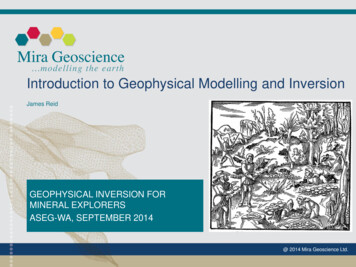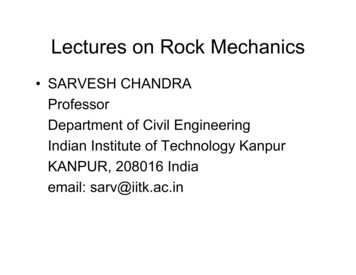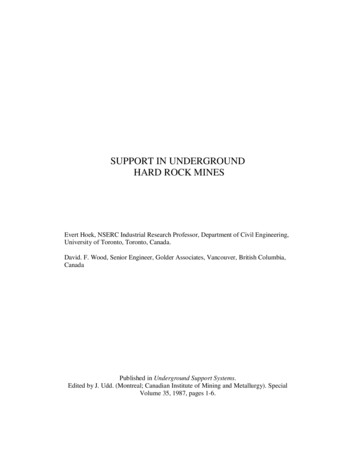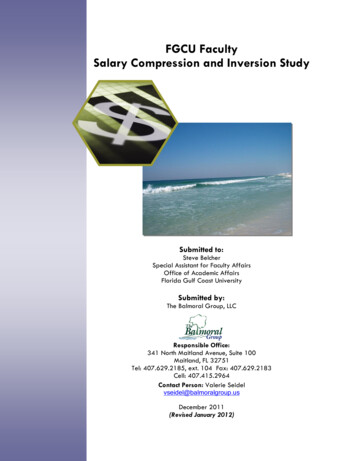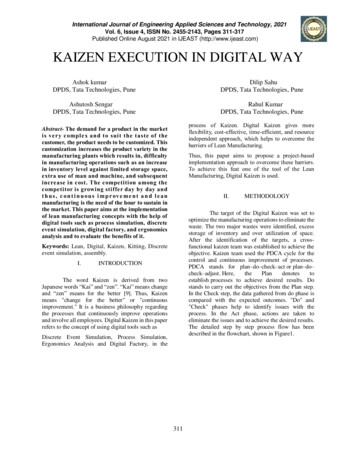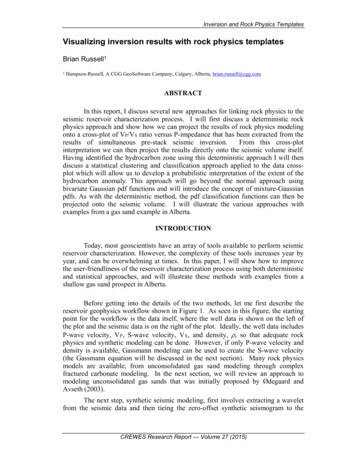
Transcription
Inversion and Rock Physics TemplatesVisualizing inversion results with rock physics templatesBrian Russell11Hampson-Russell, A CGG GeoSoftware Company, Calgary, Alberta, brian.russell@cgg.comABSTRACTIn this report, I discuss several new approaches for linking rock physics to theseismic reservoir characterization process. I will first discuss a deterministic rockphysics approach and show how we can project the results of rock physics modelingonto a cross-plot of VP/VS ratio versus P-impedance that has been extracted from theresults of simultaneous pre-stack seismic inversion.From this cross-plotinterpretation we can then project the results directly onto the seismic volume itself.Having identified the hydrocarbon zone using this deterministic approach I will thendiscuss a statistical clustering and classification approach applied to the data crossplot which will allow us to develop a probabilistic interpretation of the extent of thehydrocarbon anomaly. This approach will go beyond the normal approach usingbivariate Gaussian pdf functions and will introduce the concept of mixture-Gaussianpdfs. As with the deterministic method, the pdf classification functions can then beprojected onto the seismic volume. I will illustrate the various approaches withexamples from a gas sand example in Alberta.INTRODUCTIONToday, most geoscientists have an array of tools available to perform seismicreservoir characterization. However, the complexity of these tools increases year byyear, and can be overwhelming at times. In this paper, I will show how to improvethe user-friendliness of the reservoir characterization process using both deterministicand statistical approaches, and will illustrate these methods with examples from ashallow gas sand prospect in Alberta.Before getting into the details of the two methods, let me first describe thereservoir geophysics workflow shown in Figure 1. As seen in this figure, the startingpoint for the workflow is the data itself, where the well data is shown on the left ofthe plot and the seismic data is on the right of the plot. Ideally, the well data includesP-wave velocity, V P , S-wave velocity, V S , and density, ρ, so that adequate rockphysics and synthetic modeling can be done. However, if only P-wave velocity anddensity is available, Gassmann modeling can be used to create the S-wave velocity(the Gassmann equation will be discussed in the next section). Many rock physicsmodels are available, from unconsolidated gas sand modeling through complexfractured carbonate modeling. In the next section, we will review an approach tomodeling unconsolidated gas sands that was initially proposed by Ødegaard andAvseth (2003).The next step, synthetic seismic modeling, first involves extracting a waveletfrom the seismic data and then tieing the zero-offset synthetic seismogram to theCREWES Research Report — Volume 27 (2015)
Russellstacked seismic data. After this, pre-stack synthetics can be created and compared tothe pre-stack seismic data. In this paper, we will not discuss synthetic tieing andmodeling, but will assume that these steps have been done.Figure 1: A reservoir geophysics workflow.Next, we come to the seismic data input stream shown in Figure 1. Afundamental decision on how to proceed will come with the type of data available inthe project. If only post-stack data is available, you will be limited to post-stackinversion, in which the result is P-impedance, the product of density and P-wavevelocity. If pre-stack data with offset or angle information is available, then full prestack inversion can be implemented, which results in P-impedance, S-impedance anddensity (from which other elastic volumes like V P /V S ratio, Poisson’s ratio, Young’smodulus, lambda-mu, lambda-rho and V P and V S can be generated). In this talk, wewill apply pre-stack inversion to our gas sand example, and will show how the resultspicked interactively from various lithological and fluid zones on the inverted datasetcan be displayed on a cross-plot and itegrated with a rock physics template.As also shown in Figure 1, if the pre-stack data has been recorded with a fullrange of azimuths, AVAz analysis can be applied and fracture identification can beperformed. However, on the dataset used in this study, azimuth information was notavaialable.In the final step shown in Figure 1, note that all of our rock physics andseismic attributes can be integrated using either multivariate or Bayesian statistics. Inthis study, the last section will show how Baysian statisitics, using both bivariateGaussian and mixture Gaussian pdf functions, can be used to assign a probabilitydistribution to each lithological or fluid zone picked from the seismic data andintegrated with the rock physics model. This allows us to quantify the probability offinding a hydrocarbon zone in other parts of the survy.First, we will look at the well log data used in the study, and cross-plot thisdata in a form that will be used throughout the analysis.CREWES Research Report — Volume 27 (2015)
Inversion and Rock Physics TemplatesTHE COLONY WELL DATAThe dataset used in this study is a shallow gas sand over the Colony formationin southern Alberta. Figure 2 shows the well logs recorded in a well drilled into thisgas sand. Note that the gas sand is roughly ten metres thick between depths of 632 mand 642 m. The P-wave sonic log and density logs shown in Figure 2 were recordedin-situ, whereas the S-wave sonic log was created using Castagna’s equation(Castagna et al., 1985) outside the gas sand zone, and Gassmann fluid replacementmodeling within the gas sand zone.Figure 2: The well log suite for the producing well in the Colony gas sand.Castagna’s equation is given byVS a bVP(1)If other wells in the area contain V P and V S curves, the coefficients in equation 1 canbe obtained through a local regression. However, since no observed V P and V Scurves are available in this area, the coefficients used here are the inverse of thosefound in Castagna et al. (1985), which are a -1172 m/s and b 0.862.The Gassmann equation is given byK dryKfK sat ,K m K sat K m K dry φ (K m K f )(2)where K sat is the saturated bulk modulus, K dry is the dry bulk modulus, K m is themineral bulk modulus and φ is the porosity of the reservoir rock, and K f is the bulkmodulus of the reservoir fluid.To estimate the K dry value, we used the method proposed by Greenberg and Castagna(1992), which involved the following iterative scheme:CREWES Research Report — Volume 27 (2015)
Russell1. Estimate the brine-filled P-wave velocity using an initial guess.2. Compute the S-wave velocity from the regression line given in equation 1.3. Perform Gassmann fluid substitution with the values from steps 1 and 2 tocompute the P-wave velocity for the S W 1 case. This requires estimates ofthe moduli and density of each component.4. Based on the error between the measured and computed P-wave velocities (forS W 1), go back to step 1 and perturb the estimate of the brine-filled P-wavevelocity.5. Iterate until the in-situ saturated P-wave velocities agree.The fluid bulk modulus K fl , is computed by the Reuss average given byS1SS w gas oil ,K fl K w K gas K oil(3)where in this case we set S w S gas 0.5 and found the values of the bulk moduliusing the equations giving in Batzle and Wang (19--).We can then compute each new saturated bulk modulus value by re-arrangingequation 2 to givexK sat K m,(3)1 xK dryK fl, and varying the values of φ (the porosities arewhere x K m K dry φ ( K m K fl )computed using the density log in Figure 1.Once we have computed the dry rock bulk and shear moduli at different porosities,we can use the Gassmann equation (equation 7) to model the saturated rockproperties. Gassmann’s theory predicts that the shear modulus is independent offluid content, or(4)µ sat µ dry .Finally, we plug the new values of the bulk and shear moduli into theequations for P and S-wave velocity in the saturated, porous reservoir, given byVP sat VS sat K sat 43 µ satρ sat, andµ sat,ρ sat(5)(6)where the density values can be taken from the measured density log. Note that theV P /V S ratio log shown in Figure 1 can now be computed over both the wet and gaszones, and the P-impedance log (not shown in Figure 1) can be computed bymultiplying the P-wave sonic by the density log.CREWES Research Report — Volume 27 (2015)
Inversion and Rock Physics TemplatesNow we can analyze the zone between 600 and 700 m by cross-plotting theV P /V S ratio log against the P-impedance log, as shown in Figure 3.Figure 3: Cross-plotting the well log data shown in Figure 2, where the vertical axis represents V P /V S ratio and thehorizontal axis represents P-impedance, the product of density and P-wave velocity.Note that the cross-plot shown in Figure 3 displays a number of obviousclusters of points. These clusters can be analyzed statistically using the autoatic Kmeans with Mahalanobis (or statistical) distance algorithm (Russell, 2003). Figure 4shows the results of running this algorithm using five clusters.Figure 4: Here we have performed automatic clustering using statistical K-means and found 5 clusters.CREWES Research Report — Volume 27 (2015)
RussellHowever, the key question in Figure 4 is how to interpret these fiveautomatically picked clusters. In the next section we will discuss a rock physicstemplate deterministic method which allows us to do such an interpretation.THE ØDEGAARD/AVSETH ROCK PHYSICS TEMPLATEØdegaard and Avseth (2003) presented a technique for the interpretation ofelastic inversion results using what they called the rock physics template, or RPT,approach. In this method, they compute a theoretical template consisting of values ofV P /V S ratio versus acoustic impedance (ρV P ) and compare this template to resultsderived from both well logs and t he inversion of pre-stack seismic data. To computethe values of velocity ratio and acoustic impedance, Ødegaard and Avseth (2003)compute K dry and µ dry as a function of porosity, φ, using Hertz-Mindlin contact theory(Mindlin, 1949) and the lower Hashin-Shtrikman bound (Hashin and Shtrikman,1963). The authors also incorporate the critical porosity method for the computationof the porous and solid phases. The bulk modulus computation is given as 1K dry φ / φc1 φ / φc4 µ HM ,3 K HM (4 / 3) µ HM K m (4 / 3) µ HM (7)and the shear modulus computation is given as 1µ dry φ / φc1 φ / φc z, µ HM z µ m z where HM is an abbreviation of Hertz-Mindlin,(8)13 n (1 φc ) µP ,K HM 2 18π (1 ν m ) 222m215 4ν m 3n 2 (1 φc ) 2 µ m2 3µ 9 K 8µ HM , P effectiveµ HM P , z HM HM 226 K HM 2 µ HM 5(2 ν m ) 2π (1 ν m ) pressure, K m and µ m are the mineral bulk and shear moduli, n the number ofcontacts per grain, ν m is the mineral Poisson’s ratio and φ c is the high porosity endmember.The saturated density can be computed from the equationρsat ρm (1 φ ) ρw S wφ ρg S gφ ρo Soφ .(9)where the subscripts m, w, g and o indicate matrix, water, gas and oil, S is the fractionof saturation of each fluid component. Fluid substitution is then done using theGassmann equation, which was given earlier in equation 2. The saturated modulus isequal to the dry modulus, as shown in equation 4. We then plug the values of thebulk and shear moduli as a function of porosity and water saturation into theequations for P and S-wave velocity given by equations 5 and 6. From equations 5, 6and 9 we can then compute the V P /V S ratio and the P-impedance.CREWES Research Report — Volume 27 (2015)
Inversion and Rock Physics TemplatesFigure 5 shows the computation of a set of curves in which we varied porosityand saturation using the following parameters: K m 36.8 GPa and µ m 44 GPa(which implies that ν m 0.073), n 8.64, and P 0.02 GPa. For the saturationchange we assumed a two phase gas-water system in which K water 2.92 GPa andK gas 0.021 GPa. For the density, we assumed that ρ m 2.65 g/cc, ρ water 1.09 g/ccand ρ gas 0.001 g/cc.Figure 5: Cross-plot of V P /V S ratio versus acoustic impedance for the rock physics templateusing the values given in the text (Ødegaard and Avseth, 2003). A range of porosities from 5 to40% and water saturations from 0 to 100% are shown. The colour key is fractional porosity.The template shown in Figure 5 allows us to go back and interpret the fiveclusters shown in Figure 4, as shown in Figure 6.Figure 6: Interpretation of the clusters seen in Figure 4 using the rock physics template shown in Figure 5.CREWES Research Report — Volume 27 (2015)
RussellAs seen in Figure 6, these clusters have been interpreted as shale, wet sand,gas sand and cemented sand, which corresponds to petrophysical interpretations doneon the well logs.The equations given by Ødegaard and Avseth (2003) also allow us to buildtwo-parameter templates on top of the cross-plot, as shown in Figure 7. The templateshown in this figure is given as a function of porosity and water saturation, whereporosity ranges from 4 to 16% and water saturation ranges from 0 to 100%. Note thatwe have fit the gas sandstones, cemented sandstones and some to the wet sandstonesquite well. Other rock physics templates can be built for the shale cluster.Figure 7: Superposition of set of curves created using the rock physics model of equations through on theColony well data crossplot of Figure 3.In the next section, we will apply the concept of the rock physics template toresults extracted from the pre-stack inversion of the seismic dataset recorded aroundthe gas well shown in Figure 1.THE COLONY SEISMIC DATASET AND ITS INVERSIONFigure 8 shows a small subset of CMP gathers over a seismic line that isintersects the well shown in Figure 2, as well as the resulting stack of these gathers.The gathers show a noticeable AVO Class 3 anomaly outlined around the gas sand. Aclass 3 anomaly is created by a sand shows a drop in both P-impedance and VP/VSratio, which is observed both in the log curves of Figure 2 and the interpreted crossplot of Figure 6.The bottom part of Figure 8 shows the stack of these gathers, which formspart of an amplitude “bright spot”. Note that the information contained in the prestack amplitudes that suggested this was a Class 3 anomaly has been lost in thestacking process. An amplitude “bright spot” on the seismic stack could thus indicateCREWES Research Report — Volume 27 (2015)
Inversion and Rock Physics Templateseither a gas sand or a large amplitude from another cause, such as coal beds, whichwould be termed a “false” bright spot. To discriminate true gas sand bright-spotsfrom false bright-spots was the reason that AVO analysis was first developed(Castagna et al., 1993) and many qualitative AVO techniques can be used to identifythe Class 3 gas sand shown in Figure 8. However, to compare the results shown onthe seismic gathers in Figure 8 with the crossplot shown in Figure 3, a morequantitative method of AVO analysis is required, one that produces elastic results.Figure 8: The top figure shows several seismic gathers around the well described in Figure 1, with a noticeableAVO Class 3 anomaly outlined around the gas sand. The bottom figure shows the stack of these gathers, whichforms part of a gas sand “bright spot”.The seismic gathers shown in Figure 8 were thus inverted using simultaneouspre-stack model-based inversion (Hampson et al., 2005), in which the output is Pimpedance, S-impedance and density. Since the gathers shown in Figure 8 onlycontain angles out to 30o, the density part of the inversion is not considered reliable,so only P-impedance and S-impedance were used in the interpretation. Of course,this allows us to create the V P /V S ratio versus P-impedance analysis shown in Figure3, since the ratio of the P and S impedances gives us the V P /V S ratio.The result of the seismic inversion on the seismic line shown in Figure 8 isshown in Figure 9, where the colour represents V P /V S ratio and the wiggle-tracerepresents P-impedance. As expected, the gas sand anomaly in Figure 9 shows upwith both low P-impedance and V P /V S ratio values.CREWES Research Report — Volume 27 (2015)
RussellFigure 9: Pre-stack seismic inversion of the gathers shown in Figure 8, where colour represents V P /V S ratio andwiggle-trace represents P-impedance.To create a cross-plot similar to that of Figure 3, we extracted P-impedanceand V P /V S ratio from the three zones shown in Figure 10. The shallow zone, colouredblue, is from a Cretaceous sand-shale sequence, non-anomalous. The middle zone,coloured red, was picked around the gas sand itself. The deeper zone, coloured green,is from the Devonian and represents carbonates and cemented sands.Figure 10: Three zones have been interactively picked on the dataset shown in Figure 9, where the red zonerepresents the gas sand, the blue zone represents wet sands and shales and the green zone represents cementedsands.A cross-plot of the data clusters from these three zones shown in Figure 10,with V P /V S ratio on the vertical axis and P-impedance on the horizontal axis, is shownin Figure 11. Histograms of the three clusters are also shown on the cross-plot forCREWES Research Report — Volume 27 (2015)
Inversion and Rock Physics Templatesboth P-impedance and V P /V S ratio. Note that this cross-plot can be interpreted in thesame way as Figure 6, with high V P /V S ratio, low P-impedance shales and wet sands,low V P /V S ratio, low P-impedance gas sands, and medium V P /V S ratio, high Pimpedance shales and wet sands.Figure 11: A cross-plot of the data clusters from these three zones shown in Figure 10, with V P /V S ratio on thevertical axis and P-impedance on the horizontal axis. Note the interpretation of this cross-plot from the rockphysics template shown in Figure 5.As in Figure 7, we can superimpose a rock physics template on the cross-plotshown in Figure 11. To optimize the fit, we need to modify some of the parametersthat influence the template, and the values of these parameters are shown in Figure12. Note that the effective pressure is given as the difference between the lithostaticpressure P litho and pore pressure P P .Figure 12: The parameters used in the rock physics template shown in Figure 13.CREWES Research Report — Volume 27 (2015)
RussellThe resulting rock physics template, superimposed on the cross-plot of Figure 11, isshown in Figure 13.Figure 13: The rock physics template with values shown in Figure 12 applied to the cross-plot of Figure 11.Again, the axes of this cross-plot is given by varying values of porosity andwater saturation, S W . Note that as water saturation increases, the V P /V S ratio alsoincreases, but as the porosity increases the P-impedance decreases. To project thevalues of this cross-plot onto the seismic data, we will apply a colour scale to thetemplate itself. This colour scale in shown in Figure 14.Figure 14: A rainbow-type colour palette that is applied to the rock physics template of Figure 13.The colour scheme of Figure 14, which is the default rainbow scheme, is thenapplied to the rock physics template from Figure 13, as shown in Figure 15. Note thateach grid cell, which is defined by porosity and water saturation increments, is thusdefined by a different colour. The low porosity, low water saturation sands tend tofall into the “blue-purple” bands of colour.Obviously, the next step is to transfer these colours to the seismic plot itself,and this is shown in Figure 16.CREWES Research Report — Volume 27 (2015)
Inversion and Rock Physics TemplatesFigure 15: The colour key of Figure 14 applied to the rock physics template shown in Figure 13.As expected, the sands associated with the zone 2 picks (the red colour) inFigure 10, are the ones that are coloured blue and purple from this new colourscheme. However, we have no clear idea where the gas sand is, since this colourscheme is quite “busy”.Figure 16: The colours from the rock physics template shown in Figure 15, superimposed on the seismic sectionfrom Figure 9.I therefore went back to the colour scheme shown in Figure 12 and “cleared” it bysetting all the colours to white. I then filled in certain key porosity-saturation gridcells with the colour red, as shown in Figure 17.CREWES Research Report — Volume 27 (2015)
RussellFigure 17: The colour palette shown in Figure 12 after first setting all the colours to white and then highlightingkey grid cells in red.The result of applying the new colour palette shown in Figure 17 to the seismic crosssection is shown in Figure 18. Note that the gas sand anomaly now is clearly defined.Figure 18: Application of the colour palette shown in Figure 17 to the seismic cross-section. The gas sandanomaly is now clearly identified.In the next section, we will apply statistical methods to identify the probabilityof finding the gas sand in the vicinity of the region shown in Figure 18. Specifically,we will apply Bayesian classification using both bivariate Gaussian pdf and mixtureGaussian pdf methods.CREWES Research Report — Volume 27 (2015)
Inversion and Rock Physics TemplatesBAYESIAN CLASSIFICATIONNow that we have analyzed the well log observations and seismic inversionresults using deterministic rock physics models, we will use statistical classificationmethods to examine the extent of each lithology and fluid type of each of the clustersfound in the seismic dataset (Theodoridis and Koutroumbas, 2009, Doyen, 2007).The key concept in statistical classification methods is the use of probabilitydensity functions, or pdfs, to define the characteristic shape of each cluster. The mostcommon types of pdfs are parametric, which means that they are defined by a set ofparameters. And the most common type of parametric pdf is the Gaussian pdf,defined by its mean and variance. Let’s start with the simplest case, a single variable.If we have K classes, or clusters, the kth class can be defined by the followingGaussian pdf:f ( x ck ) 1σk 1 x µkexp 2π 2 σ k 2 , (11)Nk1 Nkth class and σ 2 1(xki µk )2xrepresentsthemeanofthek kkiN k i 1N k i 1threpresents the variance of the k class. We can then define a set of lines which markthe statistical boundaries between each class. In the maximum-likelihood approachwe simply compute the boundary between the ith and jth class where the two Gaussianpdfs are equal, as follows:where µk f ( x ci ) f ( x c j )(12)In other words, equation 12 is telling us that if f ( x ci ) f ( x c j ) we select class c iand if f ( x ci ) f ( x c j ) we select class c j (Doyen, 2007).However, implicit in equation 12 is the assumption that the two pdfs haveequal weights, or priors. In the Bayesian approach, we assign different weights toeach class, as shown heref ( x ci ) p( ci ) f ( x c j ) p( c j ) ,(13)where p( ci ) and p( c j ) are called the priors (Doyen, 2007).In general, the priors are calculated by dividing the adding the total number ofpoints for all classes and computing the prior weight for each class by dividing thenumber of points in that class by the total number of points. Note that this means thatthe weights will add to one. Figure 19 shows the difference between the ML andBayesian decision boundaries for a dataset taken from North Africa, using twoclasses. Note that the effect of including priors is to reduce the size of the pdf of thecluster with the smaller prior, and thus shift the decision boundary in the direction ofthis cluster.CREWES Research Report — Volume 27 (2015)
RussellFigure 19: Decision boundaries between the Vp/Vs ratio distributions of two different clusters for a North Africanwell example, where the ML decision boundary is shown on the left and the Bayesian decision boundary on theright.When we extend the clusters to two dimensions, we can write the bi-variateGaussian pdf as 1 1 T(14)exp ( x μk ) Σ k 1 ( x μk ) ,f(x, y ck ) 1/ 2 2 2π Σ k x where x is a vector containing the x and y measurements at a particular sample, y μkx μk is a vector containing the means of the x and y values in the kth cluster, μky σ kxx σ kxy and Σ k is the covariance matrix which contains the variances of the x σ kxy σ kyy and y data values in the kth cluster, σ kxx and σ kyy , on the main diagonal, and the1 Nk [(xi µkx )(yi µky )] , on the offN k 1 i 1diagonals. Equation 14 is the equation for an ellipse. Note that equation 14 can beextended to a multi-variate distribution of any dimension, which results in anellipsoid in three dimensions and a hyper-ellipsoid in more than three dimensions.Table 1 shows the bivariate statistics for the three cluster zones shown in Figure 11.covariance of the kth cluster, σ kxy Table 1: The statistics for the three clusters shown in Figure 11, which correspond to the red cluster on the left, theblue cluster in the middle and the green cluster on the right.CREWES Research Report — Volume 27 (2015)
Inversion and Rock Physics TemplatesUsing the statistics shown in Table 1, we then compute the bivariatedistributions given in equation 13, for each of the three clusters, and superimposethese elliptical surfaces on the points, as shown in Figure 20. Each ellipse representsthe points contained within a single standard deviation from the mean. Note that wehave gone out to two standard deviations but could have added more. Also note thatwe have superimposed the univariate distributions on top of the histograms shown inthe figure. On those distributions it is easy to see where the decision boundariesoccur.Figure 20: Bivariate elliptical Gaussian pdfs computed from the statistics in Table 1 and superimposed on theclusters of Figure 11, where each contour represents a single standard deviation.Next, we superimpose the bivariate Gaussian distributions shown in Figure 20back onto the seismic cross-section, as shown in Figure 21.Figure 21: The distributions shown in Figure 21 superimposed on the seismic cross-section.CREWES Research Report — Volume 27 (2015)
RussellThe colour scheme shown in Figure 21 can be interpreted as follows byreferring to both the bivariate and univariate distributions shown in Figure 20. Thestrongest colour represents the peak on the bivariate distribution, which occurs at themean value of each cluster. The colours are then scaled down to white based ondistance from the peak, until the decision boundary is reached. When the decisionboundary is reached, the colour on the scale changes to the next cluster colour.Next, we will extend our discussion to the mixture-Gaussian approach. In thisapproach, each cluster is modeled as the sum of J Gaussian pdf functions, given byJp(x, y ck ) w j f(x, y j) ,(15)j 1Jwhere the w j represent the weights on each individual pdf function, w j 1.0 andj 1 f ( x, y j )dxdy 1.0 .Table 2 shows the three Gaussian pdfs that went into ax, ymixture model for the first cluster in Figure 11. (We will not show the mixturemodels for the other two clusters since by showing one result we get the point across.)Note that the mixture weights are all very close to 1/3.Table 2: The statistics for the three Gaussian pdfs in the mixture model for cluster 1.The three pdfs shown in Table 2 are summed to produce the mixture-modelfor the first cluster, which is shown in Figure 22, as are the mixture models of theother two clusters. Again, note that the univariate distributions have beensuperimposed on top of the histograms shown in the figure. On those distributions itis clear that we now do not have a single Gaussian function, but instead have amixture of three. The choice of the number of pdfs to use in the mixture is controlledby the user. Obviously, as the number of pdfs increases, the fit to the cluster getstighter. However, including too many pdfs in the mixture can lead to “over-fitting”,in which noise or spurious points are fit too closely. Experience has shown that theuse of three pdfs in the mixture is a reasonable choice.CREWES Research Report — Volume 27 (2015)
Inversion and Rock Physics TemplatesFigure 22: Mixture-Gaussian pdfs superimposed on the clusters of Figure 11, where each contour represents asingle standard deviation.Finally, we project the mixture-Gaussian pdf functions shown inFigure 22 back onto the seismic cross-section, as we did in Figure 21 for the singlebivariate Gaussian pdf functions. This is shown in Figure 23. As in Figure 21, thecolour scheme shown in Figure 22 can be interpreted as follows by referring to boththe bivariate and univariate distributions shown in Figure 22. The strongest colourrepresents the peak on the bivariate distribution. However, unlike in the case of asingle bi-variate Gaussian, there are multiple peaks and valleys shown in the mixtureGaussian case. Thus, when the colours are then scaled down to white based ondistance from the highest peak on the distribution, there will be multiple regions ofthe distribution that get that colour, not just a level surface based on a single ellipss.As in Figure 20, when the decision boundary is reached, the colour on the scalechanges to the next cluster colour.Figure 23: The distributions shown in Figure 22 superimposed on the seismic cross-section.CREWES Research Report — Volume 27 (2015)
RussellNote that the statistical extent of the gas sand in Figure 23 is less than itsextent in Figure 22, which is probably related to the extra complexity added by themixture Gaussian approach. Which analysis you prefer (i.e. that of Figure 23 or 24)depends on which statistical fit you believe more.CONCLUSIONSIn this report, I discussed several new approaches allowing us to link a rockphysics template to pre-stack seismic inversion. In the first part of the talk I reviewedthe theory behind the deterministic rock physics template approach, specifically foran unconsolidated gas sand model. I then showed how we could project the
m sat sat K K K K K K K K K φ, (2 ) where K. sat. is the saturated bulk modulus, dry. is the dry bulk modulus, K. m. is the . K mineral bulk modulus and . φ is the porosity of the reservoir rock, and . f. is the bulk . K modulus of the reservoir fluid. To estimate the K. dry. value, we used the method proposed by Greenberg and .

